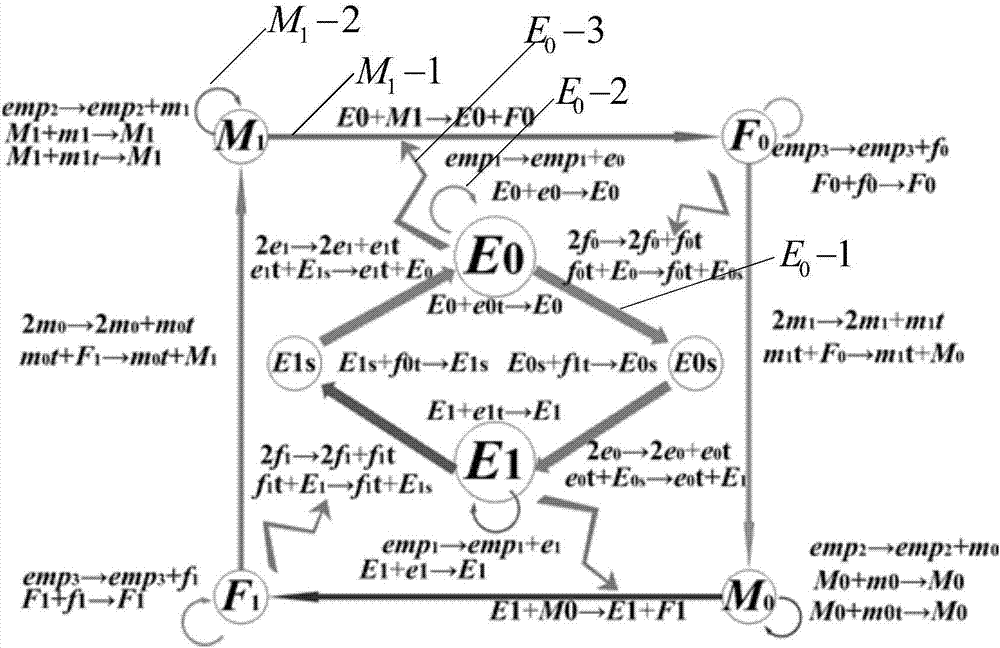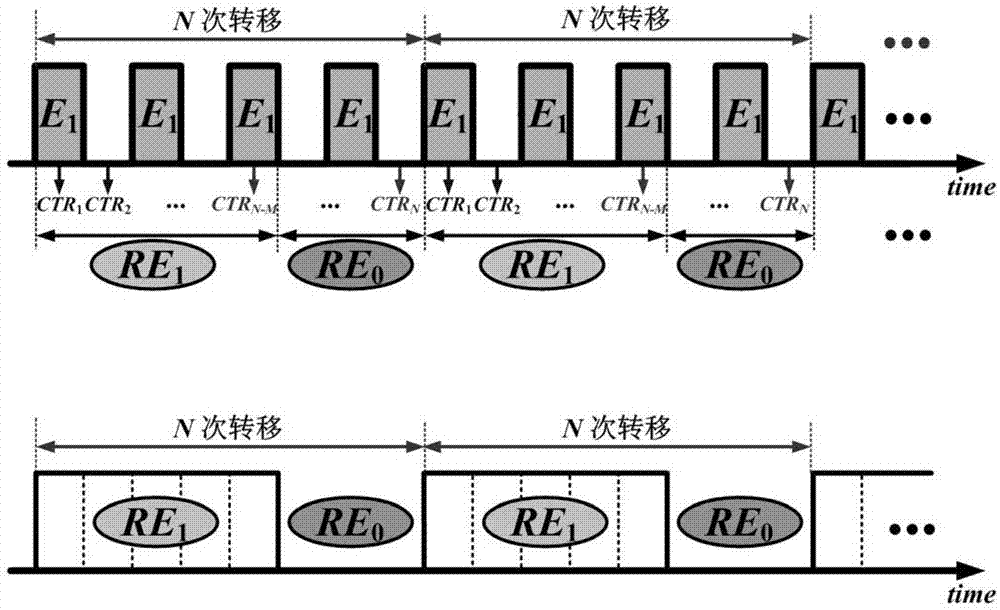Method for realizing M/N duty cycle clock signal based on monomolecular and bimolecular chemical reaction networks
A technology of chemical reaction network and clock signal, which is applied in the field of DNA computing, can solve the problems of high cost of reaction rate and difficult realization of trimolecular reaction, etc., and achieve the effect of easy realization
- Summary
- Abstract
- Description
- Claims
- Application Information
AI Technical Summary
Problems solved by technology
Method used
Image
Examples
Embodiment 1
[0055] This embodiment is specific steps for realizing a clock signal with a duty ratio of 1 / 2.
[0056] In order to realize a clock signal with a duty ratio of 1 / 2, a total of 32 chemical reactions are required, and the chemical reaction equations are shown in formulas (1)-(9). Let the clock state species of the 1 / 2 duty cycle clock signal be E 0 and E 1 , E0s and E1s are intermediate species, and the state transition of the whole molecular system is four species according to E 0 →E0s→E 1 →E1s→E 0 The form is repeated. Force signal species F 0 , F 1 ,M 0 and M 1 The generation of can be regarded as a delay unit, while the subsequent triggered chemical reaction shows the conversion of clock signal state species.
[0057] A chemical reaction network that implements a 1 / 2 duty cycle clock signal can be implemented with the aid of a square diagram, such as figure 1 shown. The square plot actually reveals the trajectory of species transfer in the cycle. Among them, eac...
Embodiment 2
[0080] For the clock signal with M / N duty ratio of N≠2, its realization is based on the clock signal with 1 / 2 duty ratio. Let the clock state species be RE 0 and RE 1 , representing the "low" and "high" logic states, respectively. The core idea of the clock signal implementation method of M / N duty ratio is to "record" the E in the phase clock signal of 1 / 2 duty ratio 0 and E 1 The number of transformations, i.e. with a set of reactants CTR i to record each transition of the clock signal, where i is an integer from 1 to N. i.e. the entire 1 / 2 duty cycle clock signal will be "packed" into segments. Each segment contains the E 0 and E 1 N conversions between, which indicates the denominator N of the duty cycle. Molecule M is realized by clock state species RE 0 and RE 1 Constructed, that is, split N conversions into two parts, one containing N-M conversions, and the other containing M conversions. Therefore, the target M / N duty cycle clock signal can be determined by...
Embodiment 3
[0089] According to the method where N is an even number, it is natural to record N transitions of the state of the original 1 / 2 duty cycle clock signal when N is an odd number. However, the two are very different in choosing the "record reactant" to change the target clock state. The main reason is that if the method of N being an even number is still used, then the next cycle (from CTR 1 to CTR N ) will not proceed. Aiming at this problem, the present invention discloses a feasible solution to the situation that N is an odd number, that is, to carry out a new cycle, which includes two steps from CTR 1 to CTR N basic cycle. Thus this new cycle can "record" 2N transitions of the 1 / 2 clock signal. Reactants that trigger clock state changes include CTR N-M 、CTR N 、CTR 2N-M and CTR 2N . The specific steps to obtain the corresponding CRNs are shown in Table 3.
[0090] Table 3 Design of M / N duty cycle clock signal when N is an odd number
[0091]
[0092] In Table 3...
PUM
 Login to View More
Login to View More Abstract
Description
Claims
Application Information
 Login to View More
Login to View More - R&D
- Intellectual Property
- Life Sciences
- Materials
- Tech Scout
- Unparalleled Data Quality
- Higher Quality Content
- 60% Fewer Hallucinations
Browse by: Latest US Patents, China's latest patents, Technical Efficacy Thesaurus, Application Domain, Technology Topic, Popular Technical Reports.
© 2025 PatSnap. All rights reserved.Legal|Privacy policy|Modern Slavery Act Transparency Statement|Sitemap|About US| Contact US: help@patsnap.com



